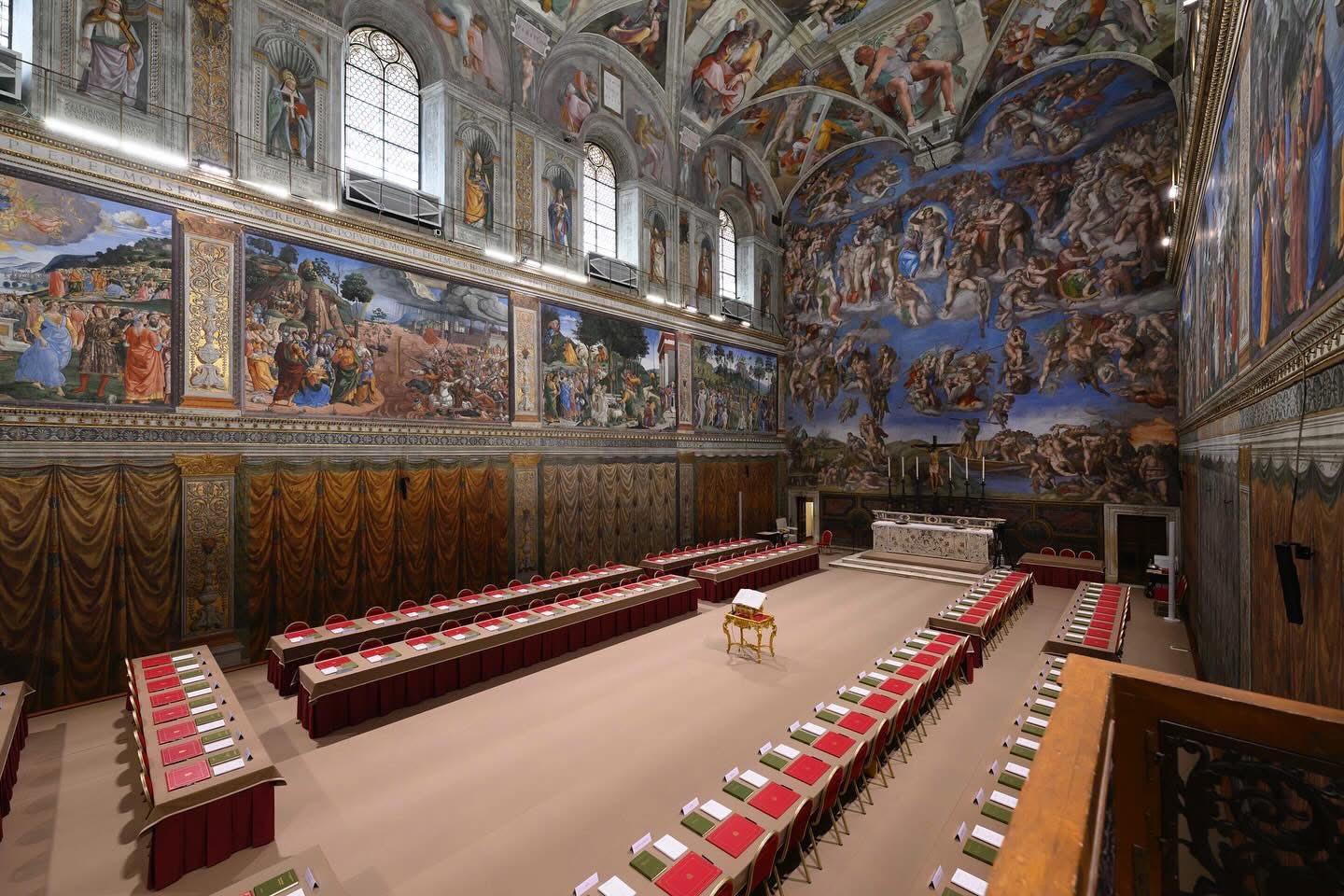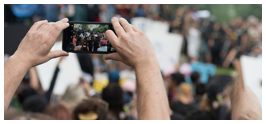After that unforgettable, once-in-a-lifetime experience of being a participant in a conclave with 132 other brother cardinals from all over the world, I understood why the election of a pope should take place nowhere else but the Sistine Chapel.
Imagine 133 cardinals in red choir dress, processing at the start of the conclave to swear an oath before the open Book of the Gospels—not all at once, but one by one. I waited patiently for my turn as our row began to move forward toward a table set in the middle of the aisle. Standing before the Sacred Book, I recited the solemn formula aloud:
“Et ego, Paulus Virgilius Cardinalis David spondeo, voveo ac iuro…”
(And I, Pablo Virgilio Cardinal David, do so promise, pledge, and swear…)
Then, touching my hand to the open Book, I continued:
“Sic me Deus adiuvet et haec sancta Dei Evangelia, quae manu mea tango.”
(So help me God and these Holy Gospels which I touch with my hand.)
That oath-taking ritual alone lasted about an hour and a half. And since I am bound by perpetual secrecy—under pain of excommunication—I cannot speak about numbers, personalities, or the dynamics that led to the election of a new pope. (Please don’t bother asking the electors; our lips are sealed.) But I can share the aesthetico-spiritual, almost mystical experience of letting my eyes feast on the masterpieces of Michelangelo that adorn this sacred chapel, the timeless stage for the conclave.
With our cellphones confiscated, there was no way to “kill time” digitally as many people do nowadays—no screens to scroll, no notifications to check. And so, as we waited for our turn at the oath, the most natural thing to do was to lift our gaze toward the towering painted retablo of Michelangelo’s Last Judgment, covering the entire altar wall.
All the figures are rendered naked—except for Mama Mary. Draped modestly in blue, she sits beside Christ, but slightly withdrawn. Her head is turned, as if she cannot bear to look directly at the scene. It is as though she, too, is overwhelmed by the unfolding drama.
This is no gentle Nativity. It is the thunderous climax of time. Michelangelo, already in his sixties when he painted it, gives us not pious serenity but terrifying truth. Christ stands at the center—not crucified but glorified. No longer only Savior, but Judge. His arm is raised—not to bless, but to decree.
Around him, the saints orbit in motion. Peter holds the keys. Bartholomew holds a knife—and on his flayed skin, Michelangelo has painted his own face, as if to confess that he, too, has been stripped bare before the gaze of eternity. Catherine clutches her broken wheel. Sebastian grips the arrows of his martyrdom.
And around them, the human race—naked, twisting, rising, falling.
To the right, the blessed are drawn upward into light. Angels grasp their wrists and waists, lifting them toward the eternal. Some are pulled upward by the rosary. Others are carried by sheer grace.
To the left, the damned tumble into chaos—dragged downward by demons, contorted by fear and shame. In the lower corner, Charon ferries the lost across the River Styx—borrowed from Dante’s Inferno. And there, grotesque and coiled by a serpent biting into his groin, is Minos, the infernal judge. Michelangelo gave him the face of a Vatican official who once criticized the nudity of the painting. His revenge, rendered in fresco, would last forever. But it still was not spared by a later order to cover some private parts.
But this is not nudity meant to seduce. It is nakedness meant to reveal. Every layer of illusion peeled away. No robes. No titles. No masks. Just the truth of who we are, body and soul, when we stand before the eyes of God.
Even the angels strain. One tugs a man by the wrist. Another hauls a struggling woman by the hips. It is not easy, this ascent to glory.
Above us, the ceiling is no less astonishing. Michelangelo, we are told, painted it decades earlier, under Pope Julius II. He worked for years on scaffolding he designed himself, with paint dripping into his eyes, his body bent in pain, his hands blistered by the labor of beauty. And yet what he left us is nothing less than Genesis in motion. (My own neck began to strain after a while. I had to stretch it in circular motions, first clockwise, then counter-clockwise whenever I felt the apparent onset of a stiff neck—perhaps making my neighbors wonder what I was doing—only to find them doing the same thing!)
Let’s continue. There is the Spirit hovering over the waters. The firmament splitting. The sun and moon summoned into being. And there—Adam, reclining, his finger reaching toward the outstretched hand of God. That millimeter of space between them: the very breath of life about to be given.
Surrounding them are the ignudi—twenty nude male youths, twisting and muscular. Mysterious. Decorative. And yet, they hold up the story of salvation, as if divine beauty must be borne on the shoulders of fragile flesh.
The side walls, often forgotten, tell the paired stories of Moses and Jesus, painted by great Renaissance masters—Perugino, Botticelli, Ghirlandaio. On one wall, Moses leads the people, receives the Law, and dies on the mountain. On the other, Jesus is baptized, calls the apostles, and entrusts the keys to Peter—an image that echoes in the authority we now exercise.
Above them, painted between the windows, are the ancestors of Christ—names most pilgrims forget in Matthew’s genealogy: Azor, Eleazar, Shealtiel, etc. And yet here, they are given flesh and face, reclining or conversing, seated with weariness and hope. The Word became flesh through them.
Beneath our feet lies a floor of inlaid marble. No one speaks of it. And yet it bears the footprints of centuries—popes and pilgrims, saints and sinners. The patterns are geometric, ordered, unchanging. A foundation for a Church that still walks forward.
As we neared the hour of voting, the iron grills caught my eye—remnants of an older ritual that once separated clergy from laity, sacred from profane. Now, they seem symbolic of a deeper divide: not between classes of people, but between hesitation and decision.
Then the voice rang out: “Extra omnes!” Everyone not part of the College was ushered out. The door was closed. The key turned.
We were alone.
Conclave. Cum clave. With a key.
Silence fell like a veil.
Even the pens for voting had been provided. And a scarlet red folder which could be used as a cover as we wrote down a name—just a family name preceded by his number as it appears in the list of 133. We stood and began to line up again. This time, not for the oath, but for the vote.
The Latin formula left each cardinal’s lips in a murmur before he cast his ballot:
“Testor Christum Dominum, qui me iudicaturus est, me eum eligere, quem secundum Deum iudico eligi debere.”
(I call as my witness Christ the Lord who will be my judge, that my vote is given to the one who before God I think should be elected.)
Each one placed his folded ballot on a small silver plate. Then gently tilted it into the urn—an unusual metal vessel that looks like two basins welded together and shaped like a little flying saucer, with a circular metal paten serving as an inverted lid. It sits atop the altar like a silent guardian of destiny.
What name is to be whispered at that moment?
What longing? What fear?
I looked up once more—one last time. The naked figures. The ascending saints. The reaching hand of Adam. The withdrawn gaze of Mary.
I felt the weight of the moment. The fire of the Spirit.
And then I whispered mine.
I placed the ballot gently on the plate, let it slide into the urn, and put back the paten on its mouth.
And entrusted it to God.
Cardinal Pablo Virgilio David of Kalookan, president of the Catholic Bishops’ Conference of the Philippines and vice president of the Federation of Asian Bishops’ Conferences, was among the 133 cardinal-electors in the 2025 conclave that elected Pope Leo XIV. A biblical scholar and outspoken advocate for human rights and social justice, Cardinal David is known for his pastoral presence in impoverished communities and his strong stance against violence, poverty, and corruption in Philippine society.







